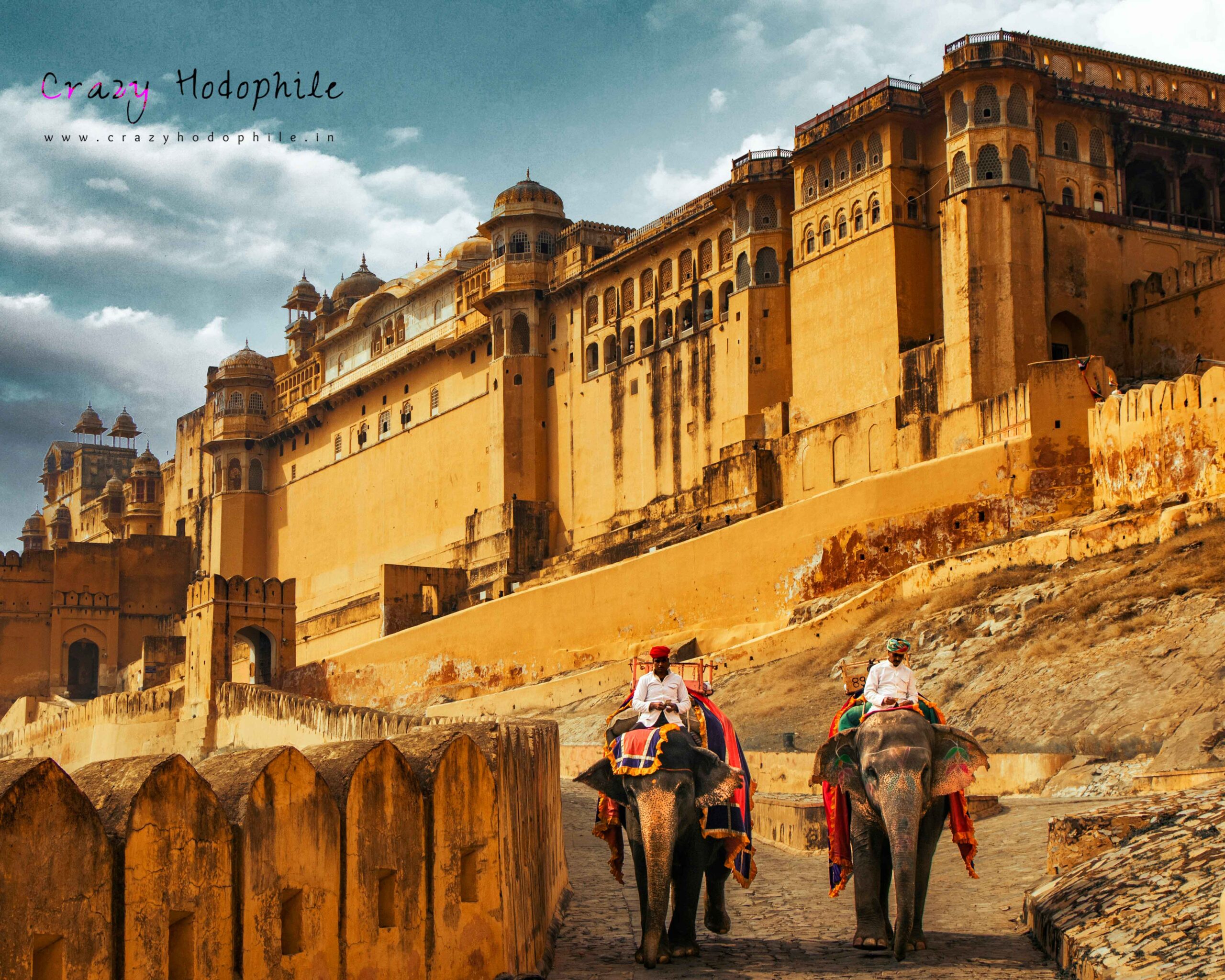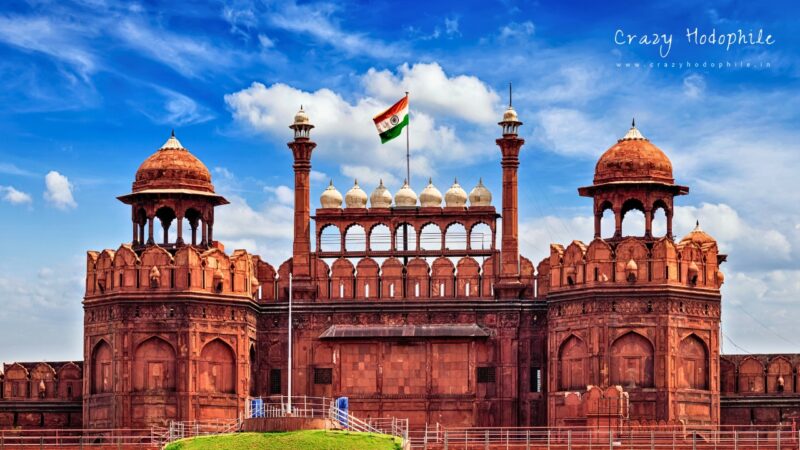Amber Fort Diaries: Capturing the Essence of Jaipur’s Heritage | Crazy Hodophile | 2025
Amber Fort, is a stunning architectural marvel and a UNESCO World Heritage Site also known as Amer Fort, and is located in the town of Amer in the Jaipur district of Rajasthan. Built in the 16th century with red sandstone and marble, it showcases a blend of Rajput and Mughal architectural styles and is the principal tourist attraction in Jaipur.
Table of Contents
History & Overview
The story of Amber Fort begins in 1592 with the initial structures built by Raja Man Singh I. Among these were the Diwan-i-Aam (the hall of public audience), and the Diwan-i-Khas (the hall of private audience). These early constructions laid the foundation for what would become a majestic fort.

Expansion and Development
Raja Man Singh’s vision was carried forward by his descendants, Jai Singh I and Jai Singh II. They expanded and enhanced the fort, adding a variety of palaces, temples, and gardens to the complex. Each addition reflected the grandeur and architectural prowess of the Kachwaha dynasty, making Amber Fort a true marvel of Rajasthan’s heritage.
Architectural Style
Amber Fort’s blend of red sandstone and white marble, combined with its detailed carvings and decorative elements, make it an architectural masterpiece showcasing the Rajput era’s artistic excellence.
Carvings and Decorations
- Detailed Carvings: The fort is adorned with intricate carvings on its walls, pillars, and ceilings. These carvings include floral patterns, geometric designs, and depictions of scenes from Hindu mythology.
- Frescoes and Paintings: Many walls and ceilings are decorated with beautiful frescoes and paintings, often illustrating royal hunts, festivals, and religious ceremonies.
Materials Used
- Red Sandstone: The primary structure of the fort is constructed from red sandstone.
- Marble: White marble is used extensively in various parts of the fort, especially in the Sheesh Mahal and Sukh Niwas.
- Glass and Mirrors: These materials have been masterfully used to construct the Sheesh Mahal, creating a dazzling effect with tiny pieces of glass reflecting light in intricate patterns.
- Limestone and Mortar (a mixture of sand and cement): These materials were used for constructing walls and providing the basic structure.
Marvels and Cultural Significance
- Temple of Shila Devi: Dedicated to the Goddess Kali, the temple is a significant religious site within the fort.
- Sheesh Mahal (Mirror Palace): It is one of the most captivating attractions within Amber Fort. This stunning architectural marvel is renowned for its intricate mirror work, which creates a mesmerizing effect as light reflects off thousands of tiny mirrors, adorning the walls and ceilings.
- Ganesh Pol (Ganesh Gate): This ornate gateway, dedicated to Lord Ganesh, serves as an entrance to the private palaces of the royal family and is a testament to the artistic brilliance of the era. It is a symbol of the royal grandeur and opulence of the Kachwaha Rajputs. The gateway’s elaborate decorations and architectural details reflect the wealth and power of the rulers.
- Mughal Gardens: The presence of Mughal gardens in Amber Fort reflects the patronage of Mughal emperors towards art, architecture, and horticulture, highlighting the cultural exchange and collaboration between Mughals and Rajputs.
Interesting Facts
- The fort has a network of hidden tunnels that connect it to Jaigarh Fort. These tunnels served as escape routes during sieges and offered a safe passage for the royal family and soldiers.
- In the Diwan-i-Khas, there is a whispering gallery where a person speaking softly at one end can be heard clearly at the other. This architectural marvel was used for confidential discussions.
- Like many ancient structures, Amber Fort is also surrounded by folklore and tales of haunting. Some locals and visitors claim to have experienced paranormal activities within its premises, adding to its mystique.
- The fort overlooks Maota Lake, which is the primary water source for the palace and adds to the scenic beauty of the location.
Opening and Closing
The opening and closing timings are as follows: 8:00 AM – 5:30 PM
Best Time to Visit
The best time to visit Amber Fort is between October and March when the weather is cool and pleasant.
Suggestion – Avoid visiting from April to July to evade the scorching heat of the city.
Entrance Fee
The entry fee for Amber Fort is INR 25 per person for Indian nationals and INR 10 per person for Indian students.
Note: These rates may have changed, so it is advisable to check the current rates upon arrival.
Activities
Sound and Light Show
Experience the enchanting Sound and Light Show at Amber Fort, Jaipur, nestled in the picturesque Kesar Kyari garden. Held every evening after sunset, typically starting after 7 pm, this 50 to 55-minute spectacle narrates the fort’s history in both English and Hindi, ensuring a rich, immersive experience for all visitors.
Tickets are priced at 250 INR
Suggestions –
- It is advisable to arrive early to secure a good seat.
- If history isn’t your cup of tea, you might want to skip this show and explore other enjoyable activities instead.
- The show is held outdoors, so it is advisable to wear warm clothes during the winter months and carry a bottle of cold water during the summer.
Elephant Safari
Tourists can experience an elephant ride up the fort, the elephant safari begins at the base of the hill and offers a delightful journey up to Amber Fort.
- Ticket Fare: The fee for an elephant ride in Amer Fort is approximately Rs 650 to Rs 1,000 per person. This fee may vary, check with the mahout before taking the ride.
- Timings: Elephant rides are available from early morning until late afternoon. However, timings may vary, so it’s advisable to check locally or with tour operators for the most up-to-date information.
Hot Air Balloon Ride
A hot air balloon ride near Amber Fort offers a truly unforgettable experience, allowing you to witness this historic marvel from a unique perspective. Here’s everything you need to know about embarking on this enchanting adventure.
When: Early morning is the best time for a hot air balloon ride, as you can witness the sunrise and enjoy the calm, cool air.
Duration: The duration of the ride is usually around a half hour to one hour, providing ample time to take in the sights and capture stunning photographs.
Price: Starting from INR 9,000 per person. Ticket prices are subject to change, so it’s advisable to check for updates when booking.
Shopping
Explore the vibrant bazaars of Jaipur, like Johari Bazaar, Tibbati Bazaar, and Bapu Bazaar.
Cultural Shows
In the evening, at various venues near Amber Fort, you can immerse yourself in the vibrant culture of Rajasthan through traditional folk dance and music performances. These shows, characterized by colorful costumes and lively music, offer a captivating glimpse into the region’s rich cultural heritage.
Location Map for Amber Fort
How to Reach
- Jaipur International Airport is the closest airport, located approximately 21 km from Amber Fort. You can take a taxi from the airport, and the journey will take about 35 to 40 minutes, depending on traffic conditions.
- The closest railway station to the Amber Fort is Jaipur Railway Station, located around 12 to 13 kilometers away. You can easily reach there from the railway station in about 20 minutes by auto-rickshaw and taxi.
- Jaipur is well connected by road. One can hire taxis or take buses from Jaipur to Amber. Sindhi Camp Bus Station is Jaipur’s main bus terminal, situated about 11 km from Amber Fort.
What’s Worth Seeing Near Amber Fort
- Jaigarh Fort: Located just above Amber Fort, known for its cannon, Jaivana, once the world’s largest cannon on wheels.
- Nahargarh Fort: Approximately 10 kilometers from Amber Fort, offers panoramic views of Jaipur city and is a perfect spot to watch the sunset over the Pink City.
- Hawa Mahal: Located about 9 kilometers from Amber Fort, the iconic “Palace of Winds,” and marvel at its stunning architecture and breathtaking city views.
- Jantar Mantar: Around 8 kilometers from Amber Fort, It is a captivating 18th-century astronomical observatory featuring the world’s largest stone sundial, a must-visit for travel enthusiasts and history buffs alike.
- City Palace: Situated approximately 8 kilometers from Amber Fort, this royal residence includes museums and courtyards that showcase the opulence and history of Jaipur’s royal family.
FAQ’s
Photo Credits:
Featured Image Credits – Gaurav Sharma



